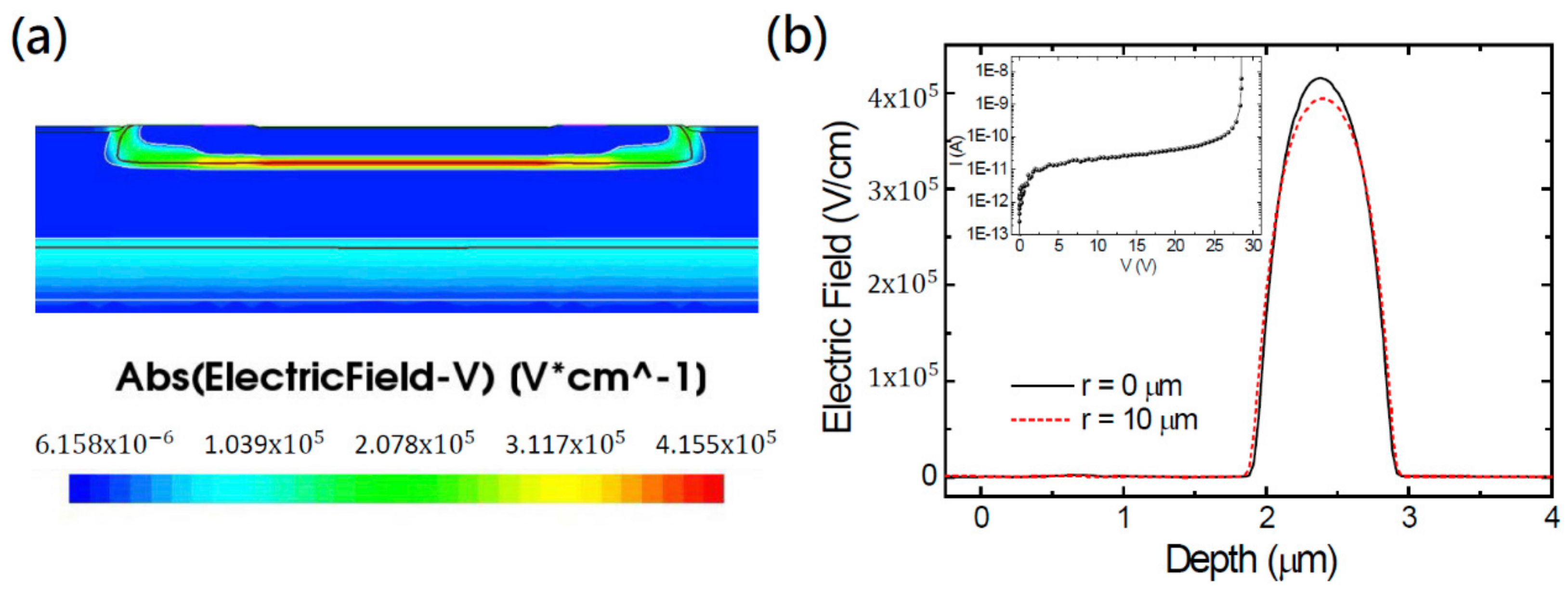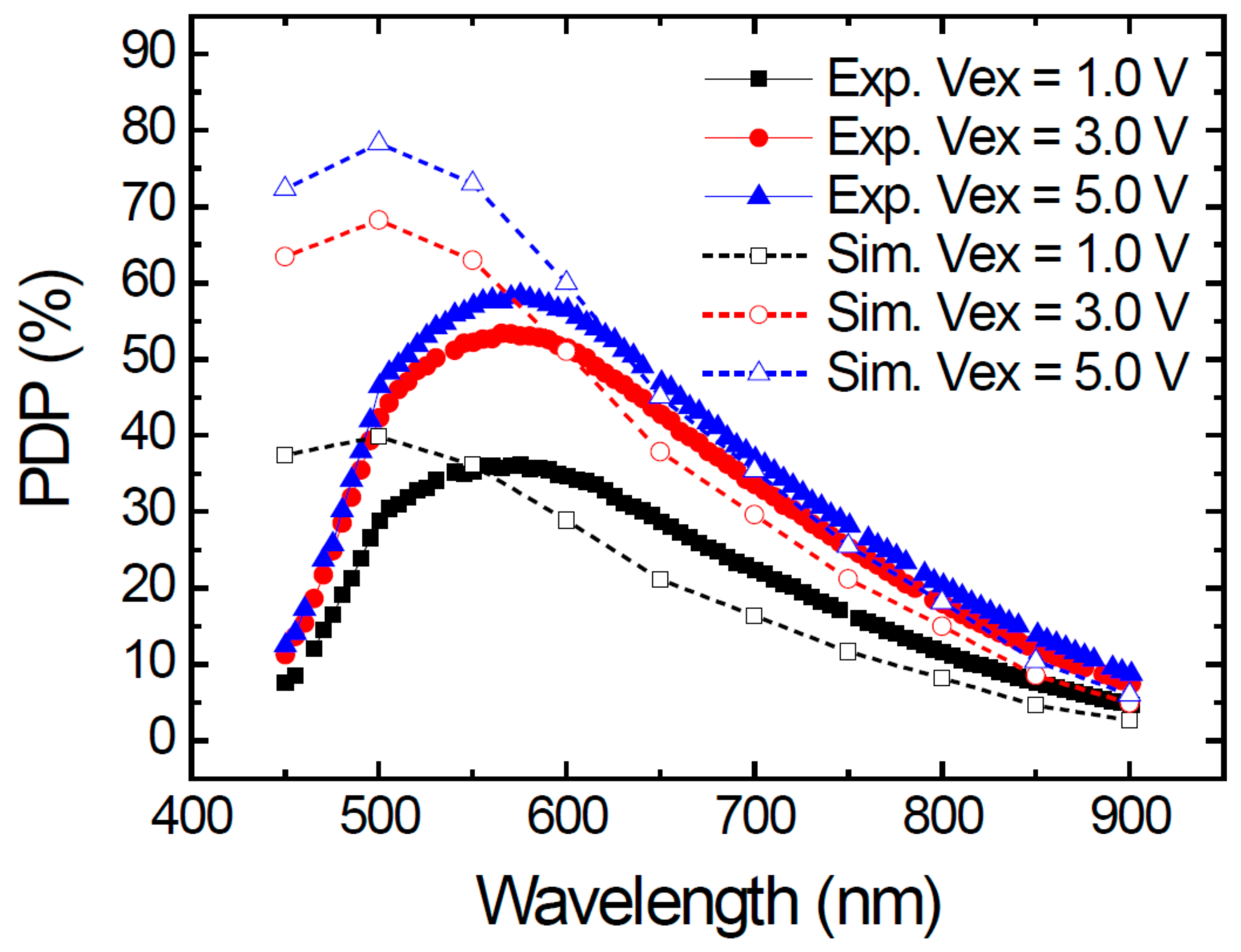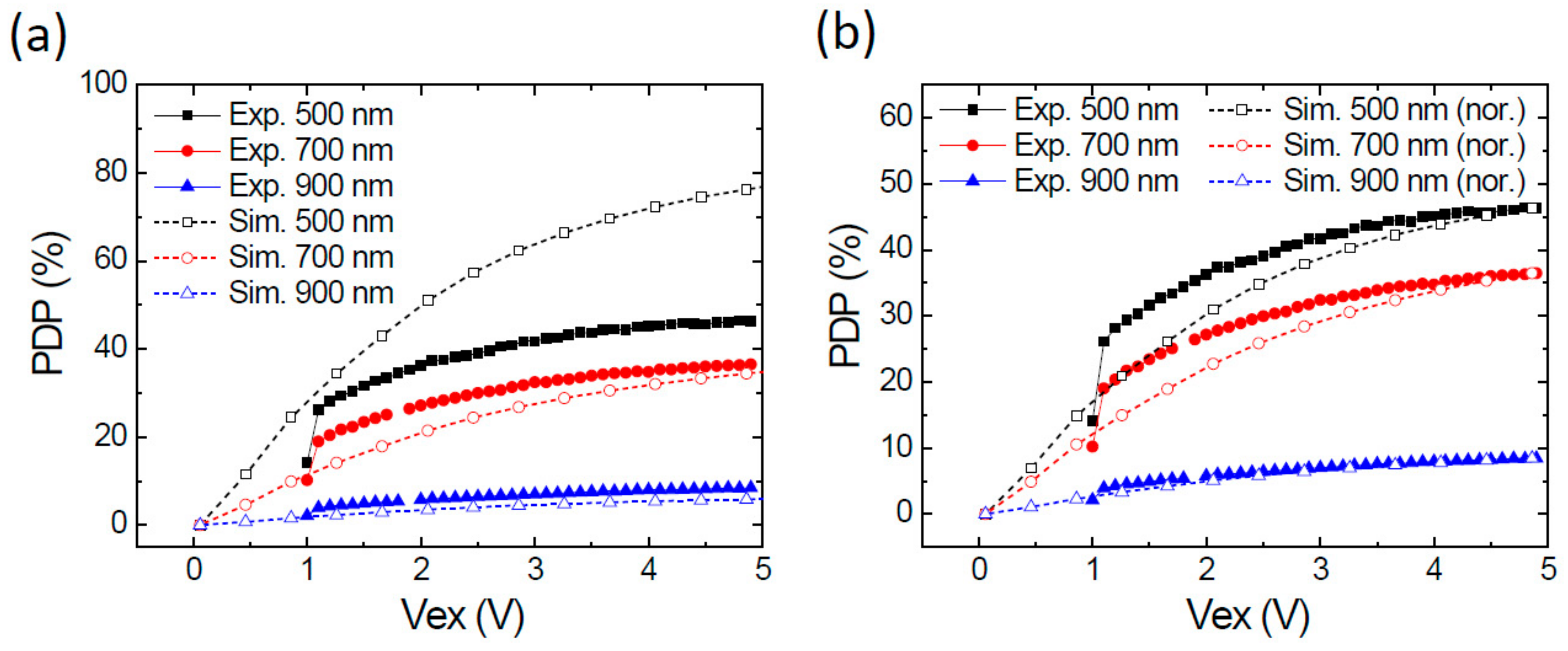Photon-Detection-Probability Simulation Method for CMOS Single-Photon Avalanche Diodes
Abstract
:1. Introduction
2. Methods and Simulation Results
2.1. Device Structure, Doping Proflies, and Electric Field Distribution
2.2. Breakdown Trigger Probability
2.3. Anti-Reflection Coating and Photo-Generation Rate Distribution
3. Experimental Results and Discussions
3.1. Experimental Method and Results
3.2. Comparison between Experimental and Thoeretical PDP
3.3. PDP Pie-Chart Analysis
4. Conclusions
Author Contributions
Funding
Acknowledgments
Conflicts of Interest
References
- Keil, G.; Bernt, H. Infrared detection by avalanche discharge in silicon p-n junctions. Solid-State Electron. 1966, 9, 321–325. [Google Scholar] [CrossRef]
- Cova, S.; Longoni, A.; Andreoni, A. Toward picosecond resolution with single-photon avalanche diodes. Rev. Sci. Instrum. 1981, 52, 408–412. [Google Scholar] [CrossRef] [Green Version]
- Rochas, A.; Ribordy, G.; Furrer, B.; Besse, P.A.; Popovic, R.S. First passively-quenched single photon counting avalanche photodiode element integrated in a conventional CMOS process with 32ns dead time. Proc. SPIE 2002, 4833, 107–115. [Google Scholar]
- Charbon, E. Single-photon imaging in complementary metal oxide semiconductor processes. Phil. Trans. A Math. Phys. Eng. Sci. 2014, 372, 20130100. [Google Scholar] [CrossRef] [PubMed] [Green Version]
- Hsu, F.Z.; Wu, J.Y.; Lin, S.D. Low-noise single-photon avalanche diodes in 0.25 μm high-voltage CMOS technology. Opt. Lett. 2013, 38, 55–57. [Google Scholar] [CrossRef] [PubMed]
- Huang, L.D.; Wu, J.Y.; Wang, J.P.; Tsai, C.M.; Huang, Y.H.; Wu, D.R.; Lin, S.D. Single-photon avalanche diodes in 0.18-μm high-voltage CMOS technology. Opt. Express 2017, 25, 13333–13339. [Google Scholar] [CrossRef] [PubMed]
- Schwartz, D.E.; Charbon, E.; Shepard, K.L. A single-photon avalanche diode array for fluorescence lifetime imaging microscopy. IEEE J. Solid-State Circuits 2008, 43, 2546–2557. [Google Scholar] [CrossRef] [Green Version]
- Li, D.U.; Arlt, J.; Richardson, J.; Walker, R.; Buts, A.; Stoppa, D.; Charbon, E.; Henderson, R. Real-time fluorescence lifetime imaging system with a 32 × 32 0.13 µm CMOS low dark-count single-photon avalanche diode array. Opt. Express 2010, 18, 10257–10269. [Google Scholar] [CrossRef]
- Homulle, H.A.R.; Powolny, F.; Stegehuis, P.L.; Dijkstra, J.; Li, D.-U.; Homicsko, K.; Rimoldi, D.; Muehlethaler, K.; Prior, J.O.; Sinisi, R.; et al. Compact solid-state CMOS single-photon detector array for in vivo NIR fluorescence lifetime oncology measurements. Biomed. Opt. Express 2016, 7, 1797–1814. [Google Scholar] [CrossRef] [Green Version]
- Henderson, R.K.; Johnson, N.; Rocca, F.M.D.; Chen, H.; Li, D.D.-U.; Hungerford, G.; Hirsch, R.; McLoskey, D.; Yip, P.; Birch, D.J.S. A 192 × 128 time correlated SPAD image sensor in 40-nm CMOS technology. IEEE J. Solid-State Circuits 2019, 54, 1907–1916. [Google Scholar] [CrossRef] [Green Version]
- Niclass, C.; Soga, M.; Matsubara, H.; Ogawa, M.; Kagami, M. A 0.18-μm CMOS SoC for a 100-m-range 10- frame/s 200 × 96-pixel time-of-flight depth sensor. IEEE J. Solid-State Circuits 2014, 49, 315–330. [Google Scholar] [CrossRef]
- Beer, M.; Haase, J.F.; Ruskowski, J.; Kokozinski, R. Background light rejection in SPAD-Based LiDAR sensors by adaptive photon coincidence detection. Sensors 2018, 18, 4338. [Google Scholar] [CrossRef] [PubMed] [Green Version]
- Wu, J.Y.; Lu, P.K.; Hsiao, Y.J.; Lin, S.D. Radiometric temperature measurement with Si and InGaAs single-photon avalanche photodiode. Opt. Lett. 2014, 39, 5515–5518. [Google Scholar] [CrossRef] [PubMed]
- Blacksberg, J.; Maruyama, Y.; Charbon, E.; Rossman, G.R. Fast single-photon avalanche diode arrays for laser Raman spectroscopy. Opt. Lett. 2011, 36, 3672–3674. [Google Scholar] [CrossRef] [Green Version]
- Kang, Y.; Lu, H.X.; Lo, Y.H.; Bethune, D.S.; Risk, W.P. Dark count probability and quantum efficiency of avalanche photodiodes for single-photon detection. Appl. Phys. Lett. 2003, 83, 2955–2957. [Google Scholar] [CrossRef]
- Gulinatti, A.; Rech, I.; Fumagalli, S.; Assanelli, M.; Ghioni, M.; Sergio, D. Modeling photon detection efficiency and temporal response of single photon avalanche diodes. Proc. SPIE 2009, 7355, 73550X. [Google Scholar]
- Pancheri, L.; Stoppa, D.; Dalla Betta, G.-F. Characterization and modeling of breakdown probability in sub-micrometer CMOS SPADs. IEEE J. Sel. Top. Quantum Electron. 2014, 20, 328–335. [Google Scholar] [CrossRef]
- TCAD (Technology Computer-Aided Design) Software Package Provided by Synopsys Inc. Available online: https://www.synopsys.com/silicon/tcad.html (accessed on 17 October 2019).
- Okuto, Y.; Crowell, C.R. Energy-conservation considerations in the characterization of impact ionization in semiconductors. Phys. Rev. B 1972, 6, 3076–3081. [Google Scholar] [CrossRef]
- Oldham, W.G.; Samuelson, R.R.; Antognetti, P. Triggering phenomena in avalanche photodiodes. IEEE Trans. Electron. Dev. 1972, 19, 1056–1060. [Google Scholar] [CrossRef]
- Veerappan, C.; Charbon, E. CMOS SPAD based on photo-carrier diffusion achieving PDP >40% from 440 to 580 nm at 4 V excess bias. IEEE Photonics Technol. Lett. 2015, 27, 2445–2448. [Google Scholar] [CrossRef]
- Webster, E.A.G.; Grant, L.A.; Henderson, R.K. A high-performance single-photon avalanche diode in 130-nm CMOS imaging technology. IEEE Electron. Dev. Lett. 2012, 33, 1589–1591. [Google Scholar] [CrossRef]










© 2020 by the authors. Licensee MDPI, Basel, Switzerland. This article is an open access article distributed under the terms and conditions of the Creative Commons Attribution (CC BY) license (http://creativecommons.org/licenses/by/4.0/).
Share and Cite
Hsieh, C.-A.; Tsai, C.-M.; Tsui, B.-Y.; Hsiao, B.-J.; Lin, S.-D. Photon-Detection-Probability Simulation Method for CMOS Single-Photon Avalanche Diodes. Sensors 2020, 20, 436. https://doi.org/10.3390/s20020436
Hsieh C-A, Tsai C-M, Tsui B-Y, Hsiao B-J, Lin S-D. Photon-Detection-Probability Simulation Method for CMOS Single-Photon Avalanche Diodes. Sensors. 2020; 20(2):436. https://doi.org/10.3390/s20020436
Chicago/Turabian StyleHsieh, Chin-An, Chia-Ming Tsai, Bing-Yue Tsui, Bo-Jen Hsiao, and Sheng-Di Lin. 2020. "Photon-Detection-Probability Simulation Method for CMOS Single-Photon Avalanche Diodes" Sensors 20, no. 2: 436. https://doi.org/10.3390/s20020436




